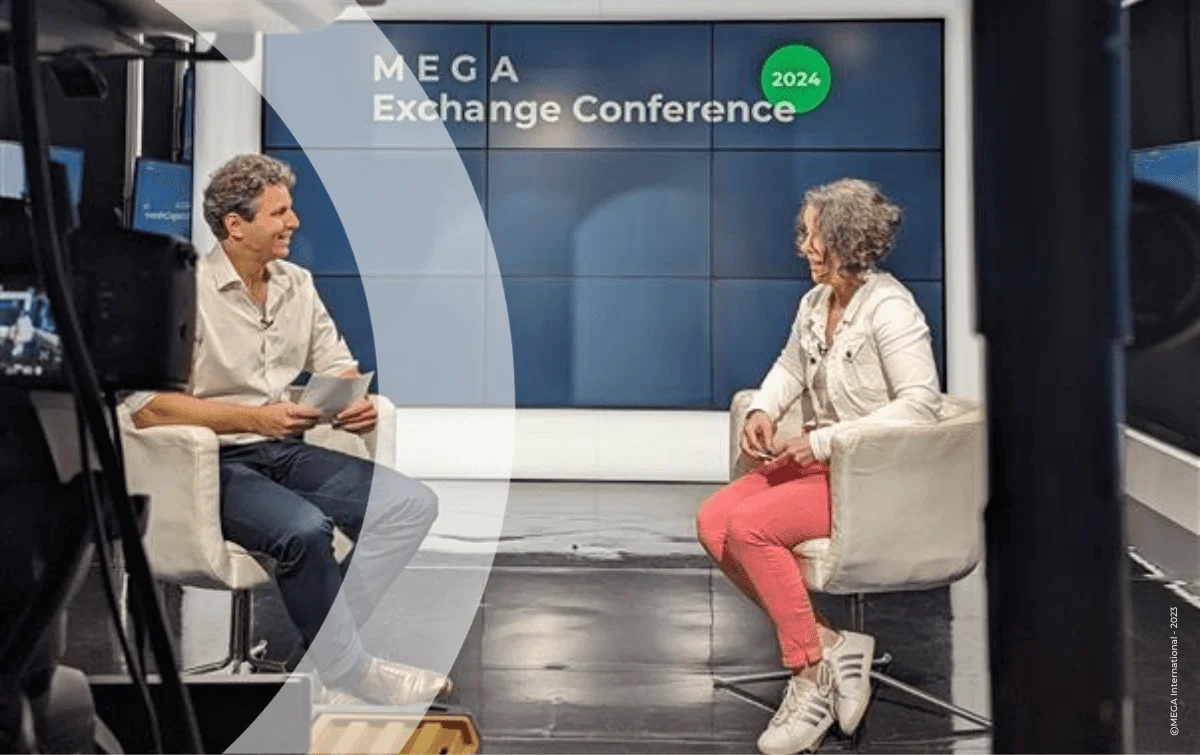
VINCI Construction: Enterprise Architecture in the Context of an Internal Merger
During the MEGA Exchange conference, Tibère de Boissezon, EMEA Director at MEGA International, interviewed Aurore Peureux, Enterprise architect at VINCI Construction, to gather her insights and advice on implementing enterprise architecture within the context of a strategic internal merger. Aurore shared her professional journey, the challenges she encountered, and the solutions adopted to establish tools and methods that promote a unified vision of the operational organization.
An Unconventional Path to Transformation
Aurore Peureux began her career in finance before transitioning to IT and functional project management. “I started as a project manager with a project management assistance role. Little by little, I discovered architecture, even though the term was not yet common at VINCI Construction.”
To fully embrace this role, Aurore pursued certification programs. “VINCI offered to train me with the EA Executive Certificate from CentraleSupélec, and I will soon start TOGAF certification.”
Her role as an enterprise architect aligns with her passion for building and innovating. “I like to build things, discover, and maintain a global vision of the company. [...] I discovered enterprise architecture, a profession I didn’t know at all, and it opened me up to a broader perspective of the organization.”
Among the projects she has managed, the deployment of the HOPEX tool was a pivotal experience, enabling her to fully immerse herself in the field of enterprise architecture while supporting VINCI Construction’s strategic transformation.
A Strategic Merger to Address New Challenges
In 2021, VINCI Construction merged with Eurovia, another branch of the VINCI group. The merger aimed to strengthen synergies and structure the organization around three key pillars:
- Large projects and complex works.
- Specialty networks, including Soletanche Bachy, Menard, Terre Armée, Freyssinet, Nuvia, and Sixense.
- Numerous local companies covering all building, civil engineering, road, and network trades.
This merger posed significant organizational challenges. “We had to rethink our organization to improve performance and prepare for short- and medium-term challenges,” Aurore explains. The Information Systems Department identified three essential priorities: conducting a comprehensive application inventory, initiating a systems convergence program, and ensuring complete traceability across architecture layers to anticipate operational impacts.
HOPEX: A Strategic Tool for Scalable Enterprise Architecture
Implementing enterprise architecture at VINCI Construction required balancing trade-offs, particularly in prioritizing projects amid sometimes conflicting expectations between strategic transformation and operational optimization. “Enterprise architecture is not a one-off project but a continuous process,” Aurore emphasizes.
To address these challenges, VINCI Construction chose HOPEX, a versatile tool that excels in application inventory management, impact analysis, and accessibility to all employees, including those outside IT services. “HOPEX met our need to integrate the different layers of architecture—business, application, and technical—while enabling progressive adoption,” Aurore highlights.
HOPEX stood out as the ideal solution due to its flexibility and robust functionality. “We immediately had a broad vision of the project. Even if we didn’t want to dive into all the layers right away, we wanted to keep the option open,” Aurore explains.
The platform offers several key advantages:
- Simplified Adoption: “The application inventory is interesting, and the publication on HOPEX 360 is particularly practical,” Aurore says. This interface, accessible to all employees, encourages engagement, even among those unfamiliar with enterprise architecture. It also supports contributors responsible for updating inventory information. “It had to be easy to access and understandable.”
- Powerful Impact Analysis: “This functionality also appealed to us,” she adds. “It is very relevant because it integrates all layers of enterprise architecture, including business, application, and technical layers.” This capability is crucial for the IT department in managing risks and ensuring service continuity.
- Scalable Implementation: “HOPEX allowed us to take a gradual approach,” Aurore notes. This step-by-step process enabled VINCI Construction to start with the fundamentals before deepening its methodology.
Gradual Deployment with a Long-Term Vision
The deployment of HOPEX at VINCI Construction is still in its early stages. “We are only at the beginning,” Aurore acknowledges. Currently, only the application inventory functionality has been implemented, focusing on applications managed directly by VINCI Construction’s IT team. However, ambitions are high.
“The next step is to roll out the feature to all willing divisions soon. And there are many! ” she adds. This collaborative approach will gradually involve more employees and enrich the architecture repository.
Beyond the application inventory, further objectives are in view. “My next goal is to use the tool for asset analyses and to evaluate the quality of our IT infrastructure,” Aurore explains. This involves leveraging HOPEX to assess the current state of the information system and identify areas for improvement.
This long-term vision aligns with a commitment to continuous improvement. “In short, evaluation and transformation follow the inventory. At that point, we will have completed the loop!” she concludes.
VINCI Construction’s experience demonstrates the central role enterprise architecture can play in managing organizational change and optimizing information systems. With the expertise of its teams and the support of the HOPEX tool, the company has established a foundation for a scalable and robust enterprise architecture.

